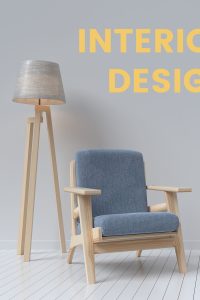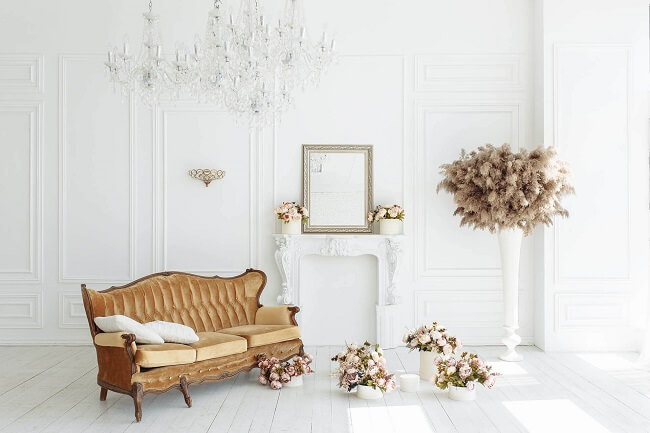A Guide To The Basics: Common Interior Design Styles
Table of Contents
Trends come and go, but true style is timeless. Interior design is a way to express yourself in your space, and to tailor the space to suit you. With so many styles to choose from, however, many people become overwhelmed and find it difficult to find the right décor for their home. To help you take a step back and look at the bigger picture so that you can find the right style for you, we’ve put together a list of the 16 most popular types of interior décor styles today.
1. Modern Style
In interior design, modern décor refers to a home with a clean and simple color scheme that relies heavily on the use of materials like glass and steel. Modern décor emphasizes a sense of simplicity in all of its elements, from furnishings to flooring. Modern interior design is inspired by mid to late 20th century décor trends, adopting clean lines and gleaming metallic accents. Distilled into a single word, this style is “sleek”. It embraces simplistic individual elements and amalgamates them into a cohesive design that gives a welcoming feel without being too loud or daring. Black, white, and greys form the basis of the color palette, complemented by hints of different prime colors like red, yellow, and blue.
2. Contemporary Style
People tend to confuse modern interior design with contemporary interior design, but there’s a significant difference between the two. The fundamental distinction that differentiates contemporary décor and modern style is that, while modern style can trace its roots to the 20th century, contemporary style is more fluid and may include a combination of other styles. Contemporary interior design usually has plain spaces that evoke a sense of clean yet classic, with details like floating furniture that gives the effect of bigger space. Contemporary styles can best be described as elegant, with complex details kept to a minimum.
3. Mid-Century Style
The mid-century style features a distinctive and unique look with clean lines, and is inspired by 1950s and 1960s design. This retro look with a nostalgic touch defines the mid-century style and incorporates components of minimalism into its overall design. The style combines natural shapes, reminiscent of the iconic “egg-shaped” chair, with clean geometric lines and patterns. Warm-toned woods are complemented by earthy tones and warm neutrals, with brass and gold accents adding a glint of glamor. This style is not limiting in terms of color palette, however, and allows for incorporating cooler tones such as emerald and deep blues. You can also approach this style from a cooler and brighter angle – white walls, cool pastel furniture, and light wood tones. As long as you combine clean geometric lines with softer natural shapes, your home will effortlessly invoke the nostalgic elements of the style.
4. Traditional Style
Traditional interior design stems from a range of vintage styles. The traditional interior style embraces deep, rich colors and dark-toned woods. These are complemented by neutral colors that highlight the rich wooden furnishings and elaborate textiles. The traditional style includes dark/stained wood paneling, coffered ceilings, bespoke cabinetry, and wainscoting. The style relies heavily on depth, layering, and dimensionality to create a timeless look and welcoming feel.
5. Rustic Style
Rustic designs are notoriously “raw” – with intentionally unfinished elements like natural wood and stone. The rustic style is heavily inspired by nature and embraces elements that come from the outdoors – a plethora of plants, natural unfinished woods, and plenty of natural light. These are complemented by soft, inviting, and plush textiles in light neutral tones. Many styles nowadays integrate elements of rustic design with more contemporary furnishings and accessories.
6. Shabby Chic Style
This style gained immense popularity in the mid-’80s and 90’s as one of the top go-to interior style designs. It’s direct counter to the overwhelmingly polished looks that are iconically 80’s, choosing instead to inspire laid-back and ethereal vibes. Ultimately, shabby chic was a victim of severe backlash as a result of being misbranded as “granny décor”. When done properly, however, it is anything but. The textiles and furniture used by this style contain an antique touch and boast a timeless, lived-in, vintage-inspired charm. Shabby chic features include hangings airy lighting fixtures, relying heavily on whites, creams, and pastels, and vintage-inspired furnishing. The most distinctive feature of shabby chic is the combination of contemporary and modern elements to achieve a unique, interesting, and somewhat rugged end result.
7. Minimalist Style
The minimalist style is one of the most popular of the modern styles. It includes super clean lines and streamlined furniture – simplicity is the key with this style. You won’t find anything extravagant or glitzy in minimalist designs, as the design’s main focus is on functionality. Minimalist style often uses natural colors to balance warmth and coolness, giving an overall feel of comforting neutrality. Minimalist interior design can be summed up into two conceptual elements – clean lines, and function over form.
8. Industrial Style
The industrial interior style intentionally rough, with unfinished metal, weathered wooden elements and exposed brick walls. Industrial interior design is inspired by the look of old repurposed factory buildings, and invoke a sturdy, rugged feel. Industrial interior design has two variants: The dark, rugged and more vintage look, and the lighter, brighter yet robust style. Depending on your taste, you can choose the look that best suits your style and needs. The more rugged take on the style leaves exposed brick entirely untreated and unfinished, for instance, while the more polished take on the style would involve a single exposed brick wall as a statement rather than a standard.
9. Scandinavian Style
This style is definitely one of the most popular interior styles, and has only grown in popularity in recent years. Scandinavian design features a clean and simple look, fully functional while emphasizing the clean lines of minimalism. This style is characterized by soft contours, light colors and tones, white and gray undertones, and natural materials. Most Scandinavian interiors have a color palette consisting of white, grey, and black, with touches of natural light woods. The clean lines and functionality are complemented with plush textiles, like chunky knit throws and sheepskin rugs.
10. Transitional Style
Transitional interior design is the happy medium of interior design. It places equal emphasis on livability and aesthetics to create a home that feels first and foremost like a home. This is achieved by combining more traditional functional pieces (such as plush sofas that are functional first and stylish second) with trendy accent pieces (accent pillows and wall décor). True transitional style incorporates the clean lines of modern design with more traditional function pieces – say a glass-top steel coffee table with a plush sofa – to achieve a home that is both immaculately styled while maintaining emphasis on day to day life. In terms of color palette, this style focuses on calm and neutral. Light natural woods, clean white walls, and carefully chosen accent pieces in serene tones. The final look is both welcoming and relaxing, and transforms your home into your own personal haven.
11. Bohemian Style
Bohemian interior design features an eclectic and creative mix of rich patterns, colors and shapes. The concept has its roots in early 19th century Europe, and borrows elements from North African and Eastern design. The golden rule of Bohemian design is that there are no hard-set rules. Bohemian style is known for its use of varied textiles, wood, fur, and even feathers. The style is inherently eclectic and invokes a worldly vibe, with a color palette that embraces both earthy, rich colors as well as bright colors and calming pastels. It incorporates metallic accents and a variety of textures – think macramé wall hangings with brass light fixtures – to form a seamless amalgamation of eclectic décor.
12. Urban Modern Style
The urban interior style descends from the sturdy lofts of the large cities, like New York and Seattle. This style takes elements from contemporary, modern, and industrial design, and creates a unique environment perfect for cosmopolitan living. Urban modern interior design features many minimalist elements, geometric prints reminiscent of mid-century modern, vintage décor accents borrowed from bohemian décor, plush extravagant furnishings straight from the traditional style playbook. The color palette starts with a bright and neutral base, with plenty of room for rich, bright accents and pops of color. Whether it be a bright yellow sofa or an emerald accent wall, you can take the style in many directions and utilize virtually any color to create a cohesive, modern, and stylish look.
13. Modern Farmhouse Style
A modern take on the more rustic farmhouse aesthetic, modern farmhouse takes homely country style and makes it sleek and polished. The style borrows the clean lines of contemporary modernism with a color palette of warm neutrals, combining them with an assortment of natural materials and textures. Punctuated with cowhide throws, southwestern-themed textiles, light tanned leather, and natural stained woods, the style is clean and welcoming. It relies heavily on natural light, utilizing it to create a bright and inviting space that is easy to live in.
14. French Country Style
Similar to modern farmhouse but with a sophisticated European twist, French country could be considered the more polished version of shabby chic. It borrows many elements from the shabby chic style, not shying away from pieces with an authentic and lived-in feel, while still maintaining an air of refined style and elegance. The style combines soft muted tones and pastels with natural woods and rich textiles, oftentimes punctuated with rich jewel tones and dramatic statement décor pieces. Metallic fixtures are elaborate and vintage-inspired while often being muted and tarnished in tone, giving an authentic rustic vibe.
15. Coastal Style
Coastal interior design is as much a mindset as it is an interior decorating style. Think summer beach house, but all year round. Blues, greens, whites, and natural wood tones come together to form a style that is light, airy, ethereal, and breezy. The style includes heavy use of light-colored wicker furniture, supplemented with soft plush textiles and cushions in bright and pastel tones. Coastal interior design is meant to invoke feelings of relaxation, with an all-over casual feel and peaceful vibe. Artwork focuses on natural elements, like seashells and driftwood, with simple prints in beachy colors.
16. Modern Country Style
The more glitzy take on modern farmhouse, modern country is a design style that focuses on rich tones and inviting furnishings. Think country hospitality, but as an interior decorating style. It borrows heavily from many other contemporary styles, including farmhouse, coastal, and even transitional, to create a space that is first and foremost welcoming. It relies heavily on darker toned woods and natural materials, while ultimately keeping the general design simple, practical, and functional. It incorporates simple décor elements, like vintage prints, and uses them sparingly. You won’t find elaborate gallery walls or dramatic modernist artwork here – the style is supposed to be inviting and practical first, and aesthetically pleasing second, steering clear of anything that could be considered showy or overly styled.

